City of Vicenza and the Palladian Villas of the Veneto, Italy: The city of Vicenza was founded in the 2nd century BC. Vicenza flourished under the rule of Venice from the 15th century until the 18th century. The work of the Italian architect Andrea Palladio (1508-1580) had a great influence on the city of Vicenza and the Veneto region. His work was based on the classical Roman and Greek architecture. The Palladian architecture had also a great influence on the architecture in Northern America and Europe, such as the Banqueting House in Studley Royal Park in England. The Renaissance architect Andrea Palladio created 23 buildings in the city of Vicenza and 3 villa's in its immediate environs. The Teatro Olimpico (Olympic Theater) was one of the masterworks of Andrea Palladio. It was his last work. After the death of Andrea Palladio, the Teatro Olimpico was completed by his pupil Vincenzo Scamozzi. Tourists have been visiting the city of Vicenza for ages. Also Goethe visited Vicenza and the Palladian villas, in his 'Italian Journey' he describes Andrea Palladio as a genius. Vicenza is situated about 40 km northwest of Padua and about 71 km west of Venice. The city of Vicenza and the Palladian Villas of the Veneto gained the status as a UNESCO World Heritage in 1994.
www.werelderfgoedfotos.nl © Copyright World Heritage Photos
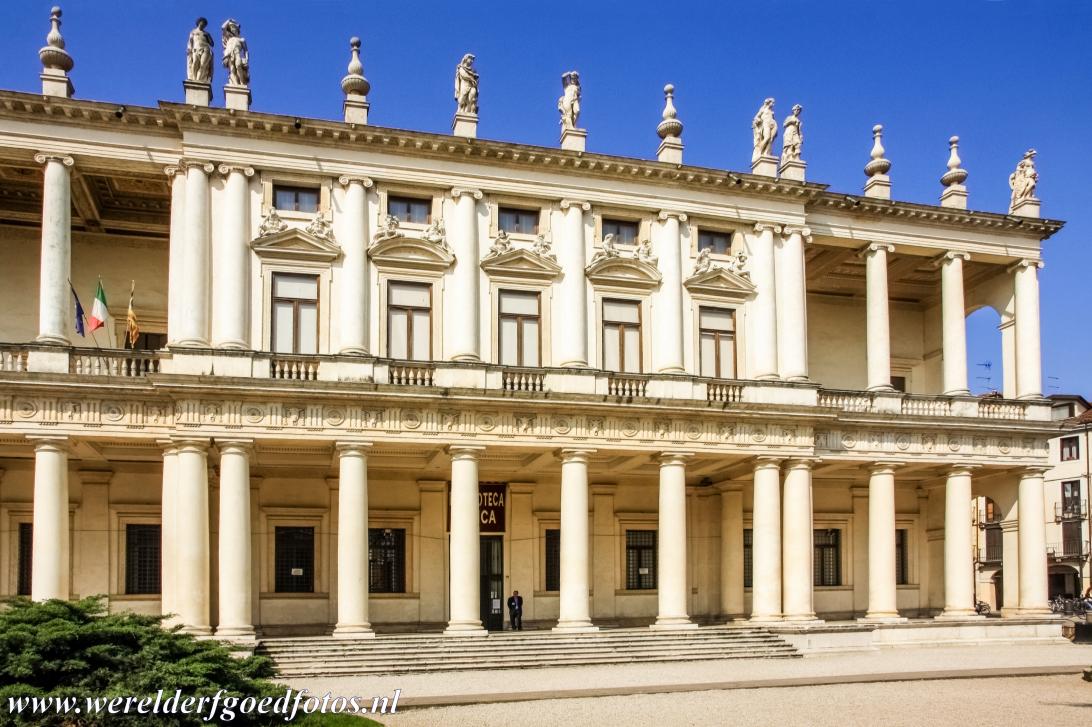
City of Vicenza and the Palladian Villas of the Veneto: The main façade of the Chiericati Palace. The Palazzo Chiericati was designed by Andrea Palladio in 1550, the works started in 1551, but was suspended in 1557. The Palazzo Chiericati was completed on the basis of Andrea Palladio's drawings in the 17the century, hundred years after his death. The Palazzo Chiericati is part of the World Heritage: City of Vicenza and the Palladian Villas of the Veneto.

City of Vicenza and the Palladian Villas of the Veneto: The main façade of the Chiericati Palace. The Palazzo Chiericati was designed by Andrea Palladio in 1550, the works started in 1551, but was suspended in 1557. The Palazzo Chiericati was completed on the basis of Andrea Palladio's drawings in the 17the century, hundred years after his death. The Palazzo Chiericati is part of the World Heritage: City of Vicenza and the Palladian Villas of the Veneto.
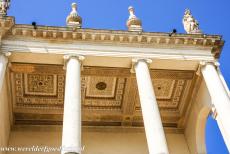
City of Vicenza and the Palladian Villas of the Veneto: The decorated ceiling of the loggia of the Palazzo Chiericati. The roofline of the palace is embellished with sculptures of Greek gods. The 16th century Renaissance Palazzo Chiericati was not fully completed until 1680. Nowadays, the palace houses the Civic Art Gallery of Vicenza, the museum houses a collection of paintings and sculptures. The Palazzo Chiericati is a UNESCO World Heritage.
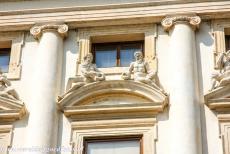
City of Vicenza and the Palladian Villas of the Veneto: The main façade of the Palazzo Chiericati is adorned with the statues of Roman and Greek gods. The columns on the lower level are Doric, the columns on the upper level are Ionic. The palace houses the Civic Art Gallery, the collection represents paintings from the 12th to the 17th centuries, uncluding work of Anthony van Dyck, one of the most famous Flemish Baroque painters of the 17th century.
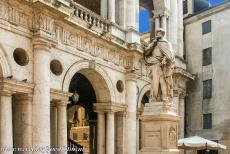
The statue of the Italian architect Andrea Palladio in front of the Basilica Palladiana in the city of Vicenza. Andrea Palladio is regarded as one of the greatest architects in the history of Western art. His designs for palaces and villas made him one of the most influential architects in Western architecture. The Basilica Palladiana is part of the UNESCO World Heritage: City of Vicenza and the Palladian Villas of the Veneto.
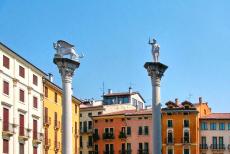
City of Vicenza and the Palladian Villas of the Veneto: The Piazza dei Signori is the main square in Vicenza. The winged lion on top of the column represents the Venetian Republic, the column on the right hand side is topped with a statue of Christ the Redeemer. The Square of the Lords, the Piazza dei Signori, is surrounded by urban palaces, among them the Basilica Palladiana and the Loggia del Capitaniato, designed by the architect Andrea Palladio.
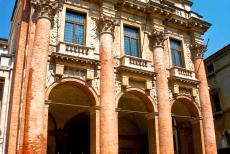
The Loggia del Capitaniato in Vicenza was designed by Andrea Palladio in 1571. The main façade of this urban palace is divided by four half-columns, topped with enormous Corinthian capitals. The Loggia del Capitaniato is also known as the Palazzo del Capitaniato, the palace is facing the Basilica Palladiana and its clock tower. The Loggia del Capitaniato is part of the UNESCO World Heritage City of Vicenza and the Palladian Villas of the Veneto.
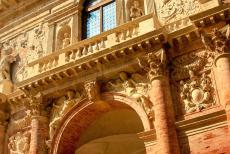
City of Vicenza and the Palladian Villas of the Veneto: A detail of the main façade of the Loggia del Capitaniato. The façade is decorated with Istrian marble. The palace was designed by Andrea Palladio in 1571. It is also known as the Palazzo del Capitaniato or Loggia Bernarda. The interior is decorated with frescoes by the Italian painter Fasolo. The Loggia del Capitaniato is situated on the Piazza dei Signori close to the Basilica Palladiana.
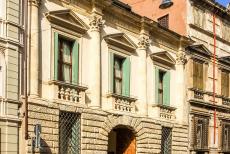
The Palazzo Schio in the city of Vicenza is the 16th century patrician palace of Bernardo Schio. The architect Andrea Palladio designed the front façade of Bernardo Schio's small urban palace in 1560. The Palazzo Schio is situated along the street Corso Andrea Palladio in Vicenza. Since 1994, the Palazzo Schio is part of the UNESCO World Heritage: City of Vicenza and the Palladian Villas of the Veneto.
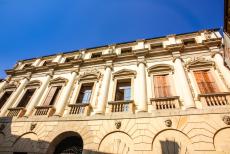
City of Vicenza and the Palladian Villas of the Veneto: The main façade of the Palazzo Porto. The palace was designed by the architect Andrea Palladio in 1544. After a difficult and long complex design process and realization, the Palazzo Porto was inhabitable from December 1549, though less then half the main façade was standing and would only be completed in 1552. The palace is part of the UNESCO World Heritage: City of Vicenza and the Palladian Villas of the Veneto.
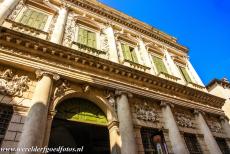
The Palazzo Barbaran da Porto in the city of Vicenza was built between 1569 and 1575 for the Vicentine nobleman Montano Barbarano. The Palazzo Barbaran da Porto is the only large urban palace that the Italian architect Andrea Palladio ever fully completed, the palace was adorned by some of the greatest artists of the time. Since 1994, the Palazzo Barbaran da Porto is part of the UNESCO World Heritage: City of Vicenza and the Palladian Villas of the Veneto.
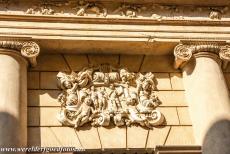
City of Vicenza and the Palladian Villas of the Veneto: A detail of the main façade of the Palazzo Barbaran da Porto. The columns of the main façade are Ionic. To decorate Palazzo Barbaran da Porto, some of the greatest artists of the time worked in the palace, such as the Italian painter Giovanni Battista Zelotti. The Palazzo Barbaran da Porto is the only palace in the city of Vicenza which was completed according to the design of Andrea Palladio.
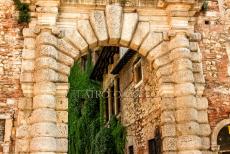
City of Vicenza and the Palladian Villas of the Veneto: The entrance gate to the courtyard of the Teatro Olimpico. The gate was designed by Vincenzo Scamozzi, a pupil of Andrea Palladio. The Renaissance architect Andrea Palladio died in 1580. Following the death of Andrea Palladio, the theatre was completed by Vincenzo Scamozzi in 1585. The Palladian architecture influenced the architecture of North America and Europe.
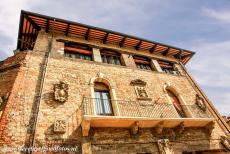
City of Vicenza and the Palladian Villas of the Veneto: The Teatro Olimpico is the oldest indoor Renaissance theater in the world. The Teatro Olimpico was the final design of Andrea Palladio. The design was based on the ancient Roman theatre of Orange in France. The Teatro Olimpico is still used several times a year. The Teatro Olimpico is part of the UNESCO World Heritage City of Vicenza and the Palladian Villas of the Veneto.
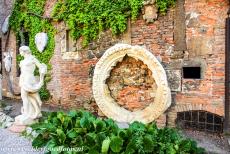
City of Vicenza and the Palladian Villas of the Veneto: The statues in the courtyard of the Teatro Olimpico. The interior of the theatre resembles the ancient Roman and Greek open-air theaters. The Teatro Olimpico is situated near the Palazzo Chiericati, both the buildings were designed by Andrea Palladio. When Palladio died in 1580, he left several unfinished buildings, among them the Teatro Olimpico in Vicenza.
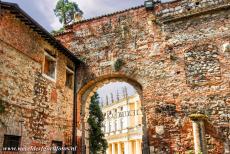
City of Vicenza and the Palladian Villas of the Veneto: The entrance gate of the Teatro Olimpico viewed from the courtyard. The Palazzo Chiericati is situated just outside the gate of the theatre. Both the buildings were designed by the architect Andrea Palladio and are situated in Vicenza. The City of Vicenza and the Palladian Villas of the Veneto became a UNESCO World Heritage in 1994. Vicenza is the city of one of the greatest architects of its time, Andrea Palladio.
